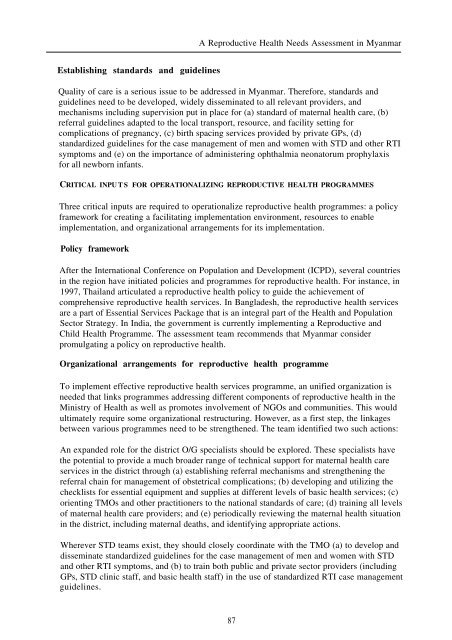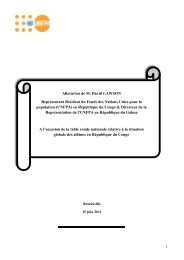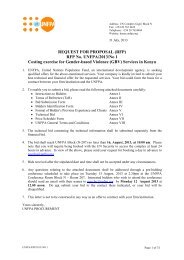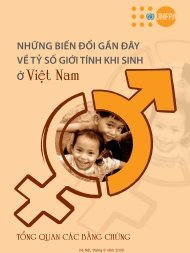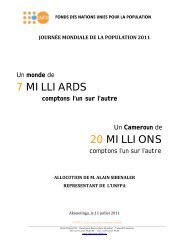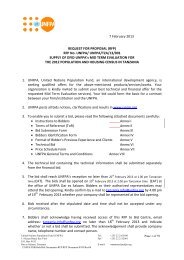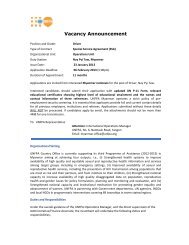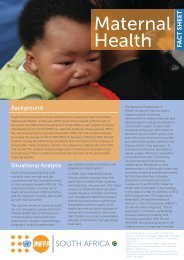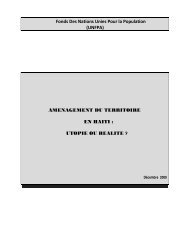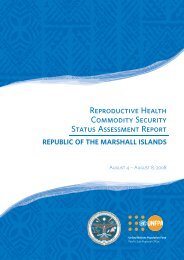A reproductive health needs assessment in Myanmar
A reproductive health needs assessment in Myanmar
A reproductive health needs assessment in Myanmar
Create successful ePaper yourself
Turn your PDF publications into a flip-book with our unique Google optimized e-Paper software.
A Reproductive Health Needs Assessment <strong>in</strong> <strong>Myanmar</strong><br />
Establish<strong>in</strong>g standards and guidel<strong>in</strong>es<br />
Quality of care is a serious issue to be addressed <strong>in</strong> <strong>Myanmar</strong>. Therefore, standards and<br />
guidel<strong>in</strong>es need to be developed, widely dissem<strong>in</strong>ated to all relevant providers, and<br />
mechanisms <strong>in</strong>clud<strong>in</strong>g supervision put <strong>in</strong> place for (a) standard of maternal <strong>health</strong> care, (b)<br />
referral guidel<strong>in</strong>es adapted to the local transport, resource, and facility sett<strong>in</strong>g for<br />
complications of pregnancy, (c) birth spac<strong>in</strong>g services provided by private GPs, (d)<br />
standardized guidel<strong>in</strong>es for the case management of men and women with STD and other RTI<br />
symptoms and (e) on the importance of adm<strong>in</strong>ister<strong>in</strong>g ophthalmia neonatorum prophylaxis<br />
for all newborn <strong>in</strong>fants.<br />
CRITICAL INPUT S FOR OPERATIONALIZING REPRODUCTIVE HEALTH PROGRAMMES<br />
Three critical <strong>in</strong>puts are required to operationalize <strong>reproductive</strong> <strong>health</strong> programmes: a policy<br />
framework for creat<strong>in</strong>g a facilitat<strong>in</strong>g implementation environment, resources to enable<br />
implementation, and organizational arrangements for its implementation.<br />
Policy framework<br />
After the International Conference on Population and Development (ICPD), several countries<br />
<strong>in</strong> the region have <strong>in</strong>itiated policies and programmes for <strong>reproductive</strong> <strong>health</strong>. For <strong>in</strong>stance, <strong>in</strong><br />
1997, Thailand articulated a <strong>reproductive</strong> <strong>health</strong> policy to guide the achievement of<br />
comprehensive <strong>reproductive</strong> <strong>health</strong> services. In Bangladesh, the <strong>reproductive</strong> <strong>health</strong> services<br />
are a part of Essential Services Package that is an <strong>in</strong>tegral part of the Health and Population<br />
Sector Strategy. In India, the government is currently implement<strong>in</strong>g a Reproductive and<br />
Child Health Programme. The <strong>assessment</strong> team recommends that <strong>Myanmar</strong> consider<br />
promulgat<strong>in</strong>g a policy on <strong>reproductive</strong> <strong>health</strong>.<br />
Organizational arrangements for <strong>reproductive</strong> <strong>health</strong> programme<br />
To implement effective <strong>reproductive</strong> <strong>health</strong> services programme, an unified organization is<br />
needed that l<strong>in</strong>ks programmes address<strong>in</strong>g different components of <strong>reproductive</strong> <strong>health</strong> <strong>in</strong> the<br />
M<strong>in</strong>istry of Health as well as promotes <strong>in</strong>volvement of NGOs and communities. This would<br />
ultimately require some organizational restructur<strong>in</strong>g. However, as a first step, the l<strong>in</strong>kages<br />
between various programmes need to be strengthened. The team identified two such actions:<br />
An expanded role for the district O/G specialists should be explored. These specialists have<br />
the potential to provide a much broader range of technical support for maternal <strong>health</strong> care<br />
services <strong>in</strong> the district through (a) establish<strong>in</strong>g referral mechanisms and strengthen<strong>in</strong>g the<br />
referral cha<strong>in</strong> for management of obstetrical complications; (b) develop<strong>in</strong>g and utiliz<strong>in</strong>g the<br />
checklists for essential equipment and supplies at different levels of basic <strong>health</strong> services; (c)<br />
orient<strong>in</strong>g TMOs and other practitioners to the national standards of care; (d) tra<strong>in</strong><strong>in</strong>g all levels<br />
of maternal <strong>health</strong> care providers; and (e) periodically review<strong>in</strong>g the maternal <strong>health</strong> situation<br />
<strong>in</strong> the district, <strong>in</strong>clud<strong>in</strong>g maternal deaths, and identify<strong>in</strong>g appropriate actions.<br />
Wherever STD teams exist, they should closely coord<strong>in</strong>ate with the TMO (a) to develop and<br />
dissem<strong>in</strong>ate standardized guidel<strong>in</strong>es for the case management of men and women with STD<br />
and other RTI symptoms, and (b) to tra<strong>in</strong> both public and private sector providers (<strong>in</strong>clud<strong>in</strong>g<br />
GPs, STD cl<strong>in</strong>ic staff, and basic <strong>health</strong> staff) <strong>in</strong> the use of standardized RTI case management<br />
guidel<strong>in</strong>es.<br />
87


